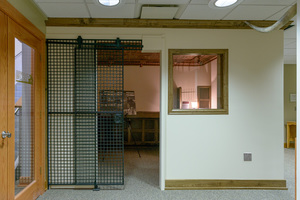C.F. Coffee Gallery to unveil banking exhibit

CHADRON – The “smell of money” is about to make its way to the C.F. Coffee Gallery.
The Coffee Gallery, located in the lower level of the Mari Sandoz High Plains Heritage Center on the campus of Chadron State College, will unveil a new exhibit later this summer focused on banking and commerce in the west, a subject that runs parallel with the development of cattle ranches in the High Plains region.
“This exhibit is really going to help define the context of the time from the 1860s to the Great Depression and it will show how the development of the cattle business in this area really mirrors the development of the banking industry,” said Steve Cleveland, President of First National Bank of Chadron and chairman of the C.F. Coffee Gallery advisory committee.
The interactive exhibit will help define three important periods in banking history, beginning with the National Banking Act of 1863 that created the Office of the Comptroller of the Currency (OCC). The act helped regulate national banking charters, but Nebraska, which wasn’t admitted to the Union until 1867, didn’t regulate state banking until the 1890s. In the time between Nebraska’s statehood and the 1890s, private banks run by entrepreneurs and capitalists were operating in unregulated formats. Since those private banks failed at a high rate, ranchers, homesteaders and others often lost their deposits. However, when Nebraska banks stabilized, businessmen had the security to pursue interests without fear of losing money.
The exhibit will also cover the Federal Reserve Act of 1913 and the Banking Act of 1933. The Federal Reserve Act provided the nation with a stable monetary and financial system, while the Banking Act of 1933 created the Federal Deposit Insurance Corporation (FDIC) to insure bank deposits.
“The timeline of the exhibit corresponds to the timeline of the banking laws,” Cleveland said. “Banking and commerce developed right alongside the cattle industry. The railroads helped people move west and the migration patterns went from there. We want people to learn from the exhibit and see just how closely its rise resembles the rise of the cattle industry and this region. Banks were so important to the ranches because they needed to do business and develop their capital. They also needed commerce because of all the employees they had. Banks really grew right alongside ranches. It was a combination of culture and life.”
That combination proved to be powerful as homesteaders and ranchers sparked local economies across the state. According to the Bank Letterhead Collection, bank charters in Nebraska went from 453 in 1887 to peaking at 1,221 in 1920. The banks provided much of the credit necessary to purchase livestock and equipment, as well as normal operating expenses.
And, the most famous banker to be featured in the new exhibit just so happens to be the gallery’s namesake – Charles F. Coffee. Coffee, who despite having the equivalent of a fifth-grade education, was an excellent businessman and rancher. He combined both of those skills in 1900 when he traded 2,000 cow and calf pairs to Bartlett Richards for the finest home in Chadron – located on the southwest corner of Fourth and Chadron – and a majority shareholding stake in First National Bank of Chadron.
“Coffee could see the country was getting too crowded and he saw the era of the large ranches being over,” Cleveland said. “He divested out of the ranch at that point and started investing in banking; he was a very wise man and began to grow his banking empire.”
The interpretive banking exhibit features a teller gate that was original to the First National Bank of Chadron at the turn of the 20th century, several telegrams and correspondence items from banks to ranches, as well as historical banking documents.
The banking exhibit is one of seven permanent exhibits at the C.F. Coffee Gallery. The others revolve around cattle origins and trails, the cowboy, open range ranching, transition on the plains, women in ranching and a comparative history of ranching in the past and present.
The gallery, which opened in 2007 and was founded with contributions from two area ranch couples, Bill and Virginia Coffee of Harrison and Charles and Barb Marcy of Hay Springs and Chadron, and the First National Bank of Chadron, also features historical branding books. The brand registration books date back to 1885 and several editions are still working documents.
The C.F. Coffee Gallery, like the Mari Sandoz High Plains Heritage Center, has free admission. It is open Monday through Friday from 8 a.m. to noon and 1 to 4 p.m., and Saturday from 9 a.m. to noon and 1 to 4 p.m.
Category: Campus News, Sandoz Society
